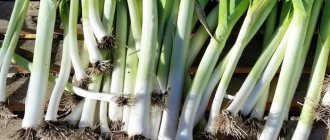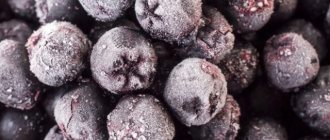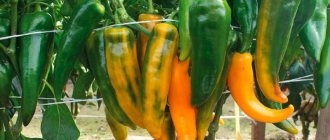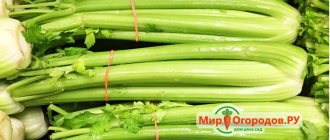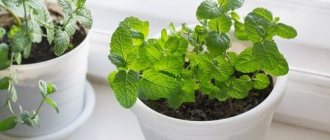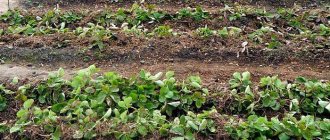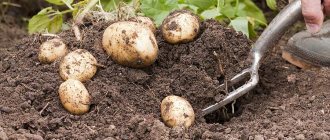What time do they dig in the fall?
Early harvesting of Japanese radish is undesirable, because in warm, dry, windy weather, the vegetable withers even under cover. It is recommended to harvest when dry, cool weather sets in. Harvesting must be done within a short period of time before the first frost occurs. They can damage the part of the root crop protruding from the ground. Then during winter storage the vegetable will begin to rot.
There is also no need to keep the daikon in the ground, because voids will begin to form inside it, the pulp will acquire a bitter taste and become tough.
Is it possible to store daikon in apartment conditions?
If you have loggias or balconies, then root vegetables can be placed in these places. Vegetables should be stored in containers and felt, insulation or foam should be used. Each fruit is placed in a box and the top is tightly closed. You don’t need to expect that such storage will be long, but if the temperature is down to minus ten then the vegetables will be fine.
To further preserve the fruits, you can wrap each root vegetable in foil, plastic or cling film. Winter clothes and a blanket are perfect to cover the daikon. When extreme cold sets in, the vegetables will need to be moved to the refrigerator.
Cleaning time
In early-ripening varieties of Japanese radish, root crops are formed within 30-35 days, in mid-ripening varieties - after 60-70 days, and in late-ripening varieties - after 90-120 days. 15-20 days before harvesting radishes, you can fertilize with ammonium sulfate, which promotes the formation of a rounded lower part in root crops and improves the quality of the peel, depending on the early maturity of the variety.
List of factors that determine the timing of cleaning:
- characteristics of the planted variety;
- time of planting in the soil;
- soil condition;
- weather;
- growing region.
For the Moscow region, Central Russia and other regions
Harvest dates depend on the region and time of planting. There are summer and winter daikon, but these names are conditional, because the first is planted in the spring and harvested in the summer, and the second is planted at the end of summer and harvested in the fall.
Advice
The harvest harvested in the autumn is usually larger than that harvested in the summer.
Daikon is a short-day crop that requires a lot of water, which is abundant in early autumn.
| Region | Timing of sowing seeds | Harvesting |
| Moscow region and middle latitudes |
|
|
| Krasnodar region |
|
|
| Ural and Siberia | End of July. | September October. |
| Sakhalin and the Far East | End of July – beginning of August. | September October. |
When to remove radishes from the garden and how to preserve them
The timing of radish harvesting depends on the climatic conditions of its growth and the types of varieties. But besides this, it is necessary to take into account weather conditions and have time to harvest before the first frost. For long-term storage of the harvested radish, a number of conditions must also be met...
What varieties of radish are suitable for storage?
There are many types of this vegetable. All of them are divided into early-ripening, mid-ripening and late-ripening varieties.
Summer varieties are early ripening and are not suitable for long-term storage. An early harvest can be placed in the refrigerator, where it will retain its beneficial qualities for about three weeks.
Mid-season and late-ripening varieties are suitable for long-term winter storage. The harvest is harvested in the fall and stored in basements and cellars. Winter types of root vegetables include:
- Chernyavka is a relatively new variety that has good taste and can be stored for a long time. From the moment of sowing until the root crop is fully ripened, 110 days pass.
- Winter white radish is considered the healthiest and most delicious variety. Characterized by good keeping quality.
- Negro is a late-ripening root vegetable with white juicy pulp. The weight of one copy reaches 300 g. Suitable for long-term storage.
- Black radish is one of the most popular and time-tested species. The vegetable retains its beneficial properties for a long time.
- Daikon or Japanese radish is becoming popular among gardeners, since the roots of this variety are large, healthy and not as bitter as, for example, black ones. For winter consumption, it is worth choosing mid-season species, such as Big Bull or Elephant Tusk.
- Margelan radish is also called Chinese or green radish because it has a green skin. The vegetable is suitable for autumn-winter consumption. Planting takes place in the second ten days of July. The product has good keeping quality.
To choose a suitable option for growing for the purpose of storing crops for the winter, you need to carefully study the description of the variety at the stage of purchasing seeds for planting.
Timing for collecting radishes of different varieties from the garden for storage
Harvest time depends primarily on the ripening of the vegetable. The optimal sowing time and ripening are indicated on the seed package. Summer species must be collected on time. Because if you leave a root crop in the garden, voids form inside it, and the juiciness disappears from the pulp.
There are a number of signs when to remove radishes from the garden for storage, but they may differ for different regions and for different varieties. So, in the climatic conditions of the middle zone (for example, in the Moscow region), Black radish or other mid-ripening and late-ripening varieties are harvested in the second half of autumn - at the end of October or early November. For colder conditions (such as Siberia) it is difficult to determine the exact harvest period. In this case, vegetable growers recommend focusing on weather conditions and harvesting before the first frost.
Harvesting summer radish harvest
The summer harvest is produced by early ripening varieties, which are sown in late April or early May. The first fruits ripen in 1.5 - 2 months. At this time, gardeners carry out selective collection for testing.
A sign that a root crop can be removed from the ground is its appearance. Specimens that have reached 3 cm in diameter are considered ripe. Most often, people consume the summer harvest immediately, so it does not require complex preparation for storage.
Harvesting autumn varieties of radish
Species that do not require long daylight hours to ripen include mid-season varieties. They produce crops starting in late summer until mid-autumn, depending on when they were sown. Daikon is one of these species; it is dug up from the garden for storage in September-October.
In order to get a harvest in a given period of time, you can use early ripening varieties if you sow them on the right days in July. To determine the best period for planting, it is recommended to use a summer resident’s calendar.
Harvesting winter varieties of radish
In relatively warm climates, winter varieties such as Black or Red radishes ripen towards the end of October or the beginning of November.
When harvesting crops for winter storage, it is important to pay attention to weather conditions. It is necessary to collect the vegetable before frost, since a frozen product partially loses its beneficial properties and cannot be stored for a long time.
How to dig up radishes correctly?
The vegetable is easily removed from the ground, but some species, such as Daikon, go quite deep into the ground. Therefore, when digging, you need to act carefully so as not to damage the integrity of the product.
Use a shovel to dig up the ground at a short distance from the root crop and remove it from the ground, holding it by the tops. The root crop is easily removed from damp soil. If the soil is dry, it is recommended to water the bed thoroughly before harvesting.
General storage tips and advice
In order for a vegetable to be stored longer in winter, it must be properly removed from the garden and prepared for storage, adhering to the following recommendations:
- Fruit collection must be carried out on a fine dry day,
- you need to dig up the root crop carefully so as not to damage it,
- after the vegetable is removed from the ground, it is laid out on the bed so that it dries,
- For storage, the radish is selected whole, without damage,
- Before storing the vegetable, it is necessary to cut the tops 1.5-2 cm from the top of the root crop.
How to store radishes?
The best storage option is boxes with holes. They allow you to accommodate a fairly large number of root vegetables and arrange them in such a way that they do not touch each other. The holes made in the container allow air to circulate freely, which has a positive effect on the safety of the product.
Before storing, vegetables must be inspected again for defects and damaged ones must be sorted out. Then the selected specimens should be placed in boxes and sprinkled with sand.
Where to store?
One of the suitable places for long-term storage of radishes is the cellar, but if the appropriate conditions are created in it:
- absence of mold and pests,
- humidity no more than 85%,
- the temperature is kept at +2…+4°С.
In a cellar or basement, under appropriate conditions, the product can retain its beneficial qualities for up to 9 months.
You can store this vegetable on the balcony or in the refrigerator. But in these places the storage duration will be significantly shorter.
( 1 ratings, average: 5.00 out of 5)
How to determine that a culture is ripe?
To determine the time of harvest, you can follow a day counting scheme. After planting, 40-70 days should pass before harvesting. It depends on the variety of white radish and weather conditions. By the time of harvesting, 2/3 of the root crops protrude from the soil and are very easily pulled out.
It is not worth keeping them in the ground longer, because... Peduncles begin to form, which leads to loss of nutrients. If you follow the growing rules and adhere to the recommended planting dates, the harvest period will be at the end of October.
How does weather affect daikon harvesting?
In addition to the fact that daikon is harvested before the first frost, it is important to focus on weather conditions on the day of harvest.
The weather should be:
- dry;
- cool;
- windy;
- sunny.
The skin of daikon is delicate and easily damaged. In dry weather, it is easier to pull out or dig up root crops without damaging them. After digging, vegetables are laid out in a dry, ventilated place, with access to sunlight for drying and subsequent cleansing of the soil.
Crops harvested under optimal weather conditions are well stored and spoil less in winter.
When harvesting in wet weather, there is a high risk of spoilage of vegetables due to the appearance of mold, mildew and damage to the skin.
Do you grow daikon?
Yes
No
Step-by-step instructions: how to assemble?
Dry, cool days are considered favorable. Frosts and hot sunny weather are harmful to root crops. If a vegetable is hit by frost, rotting processes will begin quite quickly during storage. And in the heat it withers and also becomes unsuitable for storage.
Inventory
The use of equipment depends on the quality of the soil. If the earth is dense and heavy, then you will need a shovel or forks with blunt ends. For loose sandy soil you can do without them.
Process
The collection process is not at all complicated. But root vegetables can go quite deep into the ground, and they are very fragile. Therefore, you need to harvest the crop very carefully. If the soil is loose, then just pull the tops and remove the vegetable from the ground. And for heavy soil you will need a pitchfork or shovel. Try to dig carefully so as not to damage the root crop. The root of the plant can go into the ground to a depth of 50-60 cm.
If you cannot remove the radish, you should dig around it and, shaking it, carefully remove it so that the vegetable can be easily pulled out of the ground. Separate the plants you want to keep for seed. It is better to use the summer harvest. Then the new seed will be ready in the fall.
Important!
Trim the tops, leaving petioles approximately 10 cm long. Keep the root vegetables in the refrigerator for about ten days. Replant in the ground at an angle to allow the daikon to grow until the seeds are fully ripe.
Preparation for storage
It is better to clean in dry weather. After digging, leave the Japanese radish in the garden bed in the shade for a while so that the soil on it dries out and crumbles. The skin of daikon is delicate and can be damaged very easily. Therefore, do not wash off the soil from the root crop with water or brush it off.
You can only gently shake it off with your hands or a soft cloth. Damaged vegetables will not be stored for long. Try not to expose the root crop to the sun's rays, as this will cause it to become flabby. We cut off the tops, but leave small petioles of about 2-3 cm. During storage, they will serve as a kind of indicator of freshness. If the petioles are green and not withered, then everything is fine with the root crop.
Storing daikon
Before placing vegetables for the winter, the entire radish crop is sorted and inspected. Fruits left for long-term storage must be even, smooth, and not damaged. The tops are carefully cut using scissors.
How to store daikon correctly? There are several ways to do this.
In the cellar
Placing radishes in basements and cellars is one of the best solutions. After all, it is there that optimal conditions for vegetables are created. Root crops that last the longest are those that are harvested in late September - early October.
Before harvesting, wooden boxes are purchased or made independently, then sifted through coarse river sand.
Vegetables are carefully inspected before long-term storage. Root crops with damaged skins and signs of rotting are immediately eliminated. A small stain on the surface of a different shade is a clear indication that the product has begun to deteriorate. Such a radish will not be able to last even 1 month, but it will easily destroy the crop, as it is a source of bacteria.
See also
Planting, growing and caring for daikon, when to plant in open groundRead
Daikon is laid in even layers and sprinkled with abundantly damp sand. It is important that the root vegetables only touch the sand, but not each other. Boxes are stored at a temperature of +1...+5 degrees. Humidity should be approximately 70–90%.
Ideal conditions for storing daikon are a stable temperature, lack of sunlight, and maintaining humidity in the boxes (periodically moistening the sand will help achieve this).
Dry sand can draw moisture from the radish, thereby damaging the crop.
Japanese daikon is perfectly preserved in cellars next to carrots and fodder beets.
In a refrigerator
Many gardeners grow daikon in small quantities. Their harvest includes several root vegetables that can be preserved at home in the kitchen. Each radish is wrapped in a bag that allows air to pass through. You can make holes in it with a fork. All vegetables are stored on the bottom shelf in the refrigerator. This method of storing daikon can keep the vegetables fresh for three to five weeks.
Attention! Before putting radishes in the refrigerator, you do not need to wet them, much less wash them. After all, this will quickly destroy the crop. Root vegetables can be dried and lightly cleaned of soil residues. Of course, fruits with damaged skins are eaten immediately; they cannot be stored for a long time.
Freezing
Daikon keeps well until next summer in the freezer. To do this, root vegetables are cut or grated on a coarse grater. If it is small, the radish will begin to secrete juice, and you will end up with a frozen lump of ice, which will then be problematic to eat.
Pre-crushed daikon is placed in small portions in plastic bags or special plastic containers. All this is placed in the freezer.
When you need the radish, remove it and defrost it at room temperature before using it.
Important! This method allows the beneficial microelements to be preserved in the fruits. If defrosted daikon is put back into the freezer, then such a product rich in vitamins will become a tasteless, flabby mass, devoid of any benefit.
See also
Description of watermelon radish, beneficial properties and harmRead
Conservation
You can make snacks from daikon and put them in jars for the winter. Typically, a salad is made from fresh root vegetables and carrots. Ingredients in the form of vegetables and seafood are added to it.
Refueling is selected independently at your choice:
- vegetable oil;
- mayonnaise;
- oil-lemon.
Preparing the snack begins with chopping the daikon; it can be grated on a coarse grater or cut into cubes. The radish is mixed with carrots, then everything is poured with marinade and the lid is tightly screwed on. Banks are stored in cool places.
For the marinade you will need the following ingredients:
- water;
- vinegar;
- salt;
- sugar;
- pepper;
- aromatic herbs.
The resulting mixture is brought to a boil, then cooled. Such pickled vegetables serve as the basis for winter salads, as a separate dish, or added to meat.
You can prepare a more complex marinade for daikon. First, apple and rice vinegar are mixed, then lemon zest, turmeric, garlic and hot seasoning of your choice are added. The fruits are cut into rings or half rings. This appetizer will please your household and surprise your guests.
Radish juice
The juice contained in daikon is incredibly healthy; it retains all the microelements from the root vegetable. People whose stomachs are irritated by radish fiber can drink this juice and not be afraid of the consequences.
If it is not possible to preserve root vegetables for a long time or the crop was damaged during harvesting, storing daikon juice for the winter is the best way to process excess vegetables.
Using a juicer, a drink is prepared and poured into sterilized glass jars or bottles. The container with juice is pasteurized in a water bath for half an hour. Then all containers are tightly closed with lids and placed in dark, cool places for storage.
Japanese radish is a very tasty and healthy vegetable. It contains a large amount of vitamins and beneficial microelements. If the harvest turns out to be rich, and it is not possible to eat everything at once, there are several ways to keep root vegetables fresh for many months. Thanks to this, the benefits of daikon are not lost, and the taste remains excellent.
Which variety of daikon to choose?
Now stores provide a very wide selection of seeds; preference is best given to those varieties that are bred by domestic breeders. They have better survival and adaptability specifically to our climatic conditions. All varieties can be divided into three groups depending on when to harvest daikon. They can be early, mid-early and late. The first group reaches maturity in 40-50 days. When to remove daikon from the garden is usually indicated on the bag of seeds. For storage, of course, it is best to choose late varieties. Among the cylindrical ones, the most popular are “bludgeon”, “minowasi”, “elephant’s tusk”, “big bull”. They are all mid-season. The “Sasha” variety has a spherical shape of the root crop.
Daikon. Properties, benefits, storage and recipes with daikon. Women's website www.InMoment.ru
Daikon is a Japanese root vegetable
. It resembles the familiar radish, but this vegetable is usually larger and has a milder taste. It doesn't have that burning sharpness like radishes. It was first grown in China. But now the leader in planting daikon is Japan.
Translated from Japanese, the word “daikon” means “big root”. It can actually be more than 60 cm in length and weigh several kilograms. But the shape and color of daikon depend on its variety. For example, a vegetable that resembles a giant white carrot is called Aokubi.
Turnip-shaped daikon with a pink core is the Sakurajima variety. In Russia, on store shelves you can more often find varieties such as Caesar, Terminator, Dubinushka. We call daikon sweet radish or white radish. Most often it is eaten raw, grated and seasoned with salt and vegetable oil.
In the East, it is pickled, added to salads, and used as a side dish for stews, fried fish and other dishes.
Composition of daikon
Daikon has very low energy value
. Moreover, only 300 grams of this root vegetable is enough to replenish the daily requirement of vitamin C. It is also rich in potassium salts, which help eliminate toxins and other harmful substances from the body through urine.
Among the vitamins, it is especially rich in group B substances and beta-carotene. It is rich in minerals - calcium, phosphorus, iron and magnesium. Daikon also contains phytoncides.
They protect the body from infections and improve digestion, having a bacteriostatic and bactericidal effect.
Properties and benefits of daikon
Daikon is rich in active enzymes
, which help digest starchy foods faster. In Japan, daikon is very popular for its ability to cleanse the liver and kidneys.
Only a few vegetables can dissolve kidney stones - radish, daikon and horseradish. But horseradish and radish are quite sharp foods; they contain a lot of mustard oils, which give them a pungent taste.
These root vegetables are contraindicated for the elderly and people with diseases of the digestive system. But daikon will not harm your health.
Japanese radishes contain protein substances (lysozyme) that inhibit the growth of bacteria. Therefore, it is often used as a remedy for colds. It has an antiseptic effect. It is also useful for diseases of the liver, intestines and gall bladder.
A number of researchers even believe that daikon can remove radiation from the body. It is sometimes used to prevent the development of diabetes.
Daikon is an excellent prevention of cardiovascular diseases and atherosclerosis. After all, it is rich in potassium and helps remove “bad” cholesterol from the body.
Of course, the effect of such treatment can only be noticed with regular consumption of the vegetable.
There are also contraindications for this root vegetable. Daikon should not be eaten by people suffering from kidney and liver damage, peptic ulcers, hyperacid gastritis and gout.

